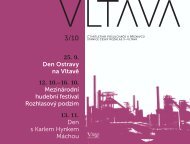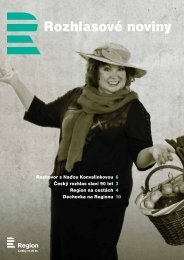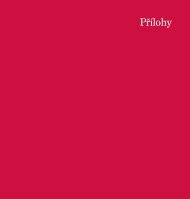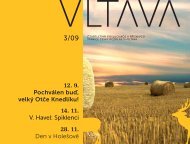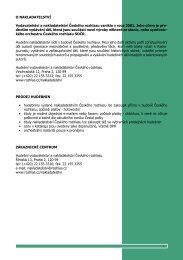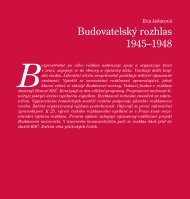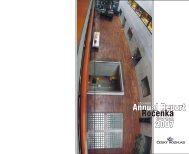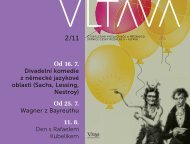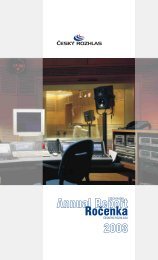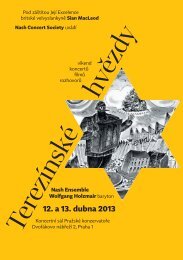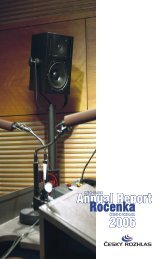Rozhlasový podzim - Český rozhlas
Rozhlasový podzim - Český rozhlas
Rozhlasový podzim - Český rozhlas
Create successful ePaper yourself
Turn your PDF publications into a flip-book with our unique Google optimized e-Paper software.
13| 10| St 19.30| Rudolfinum – Dvořákova síň<br />
13| 10| Wed 7.30 pm| Rudolfinum – Dvořák Hall<br />
already included in Cosmas’ Chronicle. This relatively brief work with a dramatic pace is – in accordance<br />
with its extramusical subject – divided into several distinctly contrasting parts, which could be described<br />
as follows: Tameless Šárka’s wild appearance – Ctirad’s ride through the forest – Love scene – The dance of<br />
Ctirad’s group with its members’ gradually falling asleep (the lovely dissonant tone of the bassoon here<br />
allegedly describes the armour-bearer’s snoring) – Šárka calling her companions (the signal of the French<br />
horn); a meditative clarinet solo follows (does Šárka eventually hesitate to carry out her intention?) – The<br />
final devastating rage.<br />
In the 1960s and 70s the Polish Composers’ School became famous. Its leading representative is Witold<br />
Lutosławski (1913–1994). In his beginnings his work was inspired by B. Bartók’s music, but he gradually<br />
developed his own characteristic style based on the dominance of colour and on some kind of soundand-colour<br />
“patches”. In this creative period he frequently used an instrumental stylization that gave the<br />
musicians a certain degree of freedom, especially in the rhythmic rendition of their parts. Lutosławski’s<br />
masterpieces include Concerto for Cello and Orchestra, which was premièred by Mstislav Rostropovich in<br />
1970. This work, exposed in one direction, is full of contrasting moods. For the opening night, the composer<br />
wrote a detailed description of the progress of the piece to the soloist, emphasising the continuous<br />
dialogue between the soloist and the orchestra. According to Lutosławski, there is a certain kind of tense<br />
“animosity”, particularly between the solo part (which begins the work with an extensive cadence) and<br />
the trumpet section.<br />
The emergence of Wojciech Kilar’s (1932) symphonic picture Krzesany in the mid-1970s meant a significant<br />
turning point in the development of European music. Before that the development of the musical<br />
language seemed to be continuously leading – though with fluctuations – towards greater and greater<br />
complexity and sophistication. The abrupt turn towards simple expression – which is also noticeable in<br />
the work of Kilar’s contemporaries, such as Gorecki, Pärt and others – disrupted this idea, which is still<br />
frequently cited nowadays. Since he wrote Krzesany, Kilar has created a lot of other works. One of the<br />
newer ones is his Concert for Piano and Orchestra from 1997. Here, the composer is influenced by the language<br />
of musical minimalism: The first movement is based on sustained consonances with little change<br />
in melody. In the slightly contrasting second movement we can hear a choral melody structure. An abrupt<br />
change comes in the final part, in which the orchestra – which has almost not played at all so far – joins<br />
in and the stream of music starts moving forward like an engine. In the final part, the choral melody from<br />
the second movement is incorporated in the frantically running music.<br />
Taras Bulba, the rhapsody for orchestra by Leoš Janáček (1854–1928), belongs among the<br />
composer’s most typical works. As a Russophile, Janáček was often inspired by Russian literature.<br />
This work is based on the novel of the same name, describing the Russian Cossacks’ fight against<br />
the Poles. Janáček chose three episodes from the book and named the three parts of the piece after<br />
them. The first part tells the story of Taras’s son, Andrii, who has left the Cossacks for the love of<br />
a Polish girl and gets punished by Taras Bulba himself, who says: “I gave you life, I will also kill you!”<br />
The second part depicts the death of the second son, Ostap, who gets captured and tortured in public<br />
by the Poles. When he cannot bear the torture any more and cries for help, calling his father:<br />
“Father! Where are you? Do you hear?” (clarinet screaming), Taras Bulba shouts from the crowd:<br />
“I hear!“ (the beat of the timpani). In the last part, Taras is burned to death and the piece ends with<br />
a wonderful apotheosis of human courage. In spite of the gloomy theme, the music is full of beautiful<br />
musical landscapes, typical of Janáček. The final part of the composition belongs among some of the<br />
most magnificent examples of any composer’s expression.<br />
14




